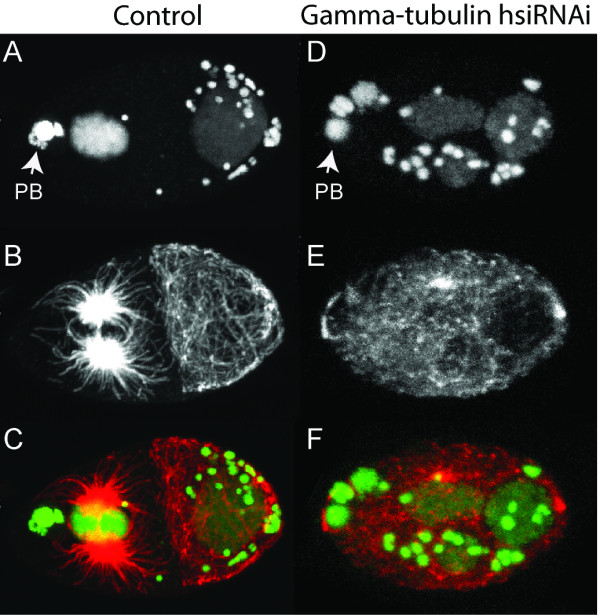Figure 1.

RNAi against γ-tubulin in B. malayi early embryos. Stained embryos from untreated (A, B, C) or γ-tubulin hsiRNA-treated (D, E, F) worms are shown. In the untreated 2-cell stage embryo (A, B, C), the anterior blastomere (oriented to the left) divides first as evidenced by the star-like spindles (B, C). In contrast, all zygotes from γ-tubulin-treated hsiRNA-treated worms (D, E, F) showed cytokinesis defects (cytokinesis did not occur) leading to polynucleated 1-cell embryos. Propidium iodide reveals the nematode DNA and the Wolbachia DNA as large and small dots, respectively (A, D). Immunostaining with α-tubulin antibody (B, E). Merge of DNA (green) with α-tubulin (red) (C, F). Anterior to the left, as indicated by the polar bodies (PB). A 445 bp fragment of the B. malayi γ-tubulin cDNA was amplified with primers: γTubF- 5'-TAATACGACTCACTATAGGGCTTCGTGAAGGTGATGCTAC-3' and γTubR 5'-TAATACGACTCACTATAGGGCACGTTCAACAGCATCACTC-3' where the T7 promoter sequence is underlined and followed by a GG nucleotide (see Methods). An annealing temperature of 56°C was used in the PCR. The cDNA fragment was transcribed and RNA diced to hsiRNA as described. Adult females were soaked for 2 days in 100 nM γ-tubulin hsiRNA and tissues fixed on the third day. Control females were kept in the same conditions and included worms cultured without hsiRNA or with a comparable concentration of Lit28i polylinker ShortCut siRNA mix.
